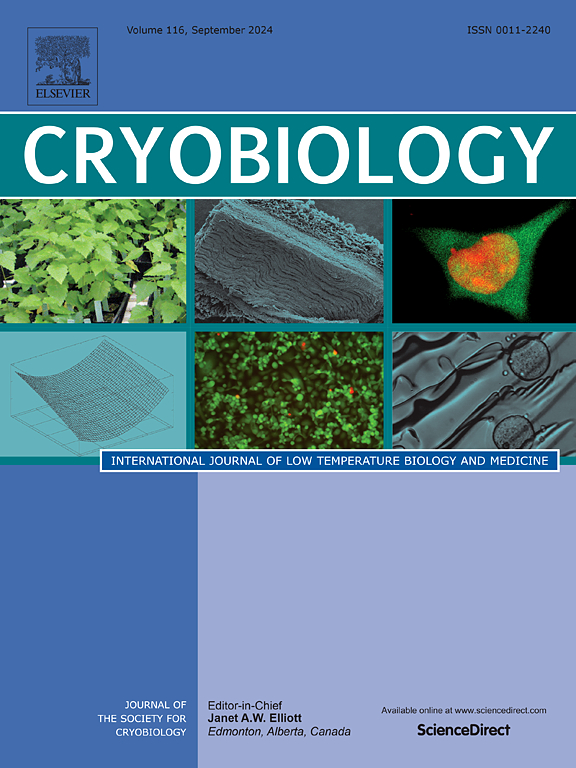Impact of lipid content on oxygen reactive species and viability predictors in vitrified bovine embryos
IF 2.3
3区 生物学
Q2 BIOLOGY
引用次数: 0
Abstract
Given the significant variation in lipid levels among bovine embryos, our study was designed to associate lipid content to oxidative stress in individual embryos undergoing vitrification, and to assess how this and other morphological parameters impacts cryosurvival. Linear and logistic regression were performed to understand the influence of the variables in the cryosurvival. T-test or Kruskal Wallis were employed to compare means. Vitrified embryos revealed a positive correlation between lipid content and oxidative stress post-warming both 2 h (p = 0.025, n = 64) and 48 h (p < 0.001, n = 122) after warming. Lipid levels explained (p < 0.001) up to 51 % (multiple R-squared) of oxidative stress variability. Compared to fresh embryos, a negative influence (p = 0.01) of vitrification-warming procedures was detected in lipid levels. Vitrified embryos exhibited lower (p < 0.001, n = 90) mean lipid content compared to fresh counterparts 48 h post-warming, and similar (p = 0.24) oxidative stress levels. No impact of lipid content or oxidative stress levels was detected on hatchability or embryo quality 48 h post-warming (n = 99). Expansion just after (0 h) and 2 h after warming resulted in a higher chance of hatching (p = 0.015 and p = 0.008, OR 1.30 and 1.58), and a positive association was observed between expansion at 0 h (p = 0.002) and embryo area (p = 0.047) with cell number. In conclusion, a decrease in lipid levels was found following vitrification-warming procedure and an individual association between lipids and oxidative stress is present in vitrified embryos. Lipids or oxidative stress levels was not linked to survivability of vitrified embryos 48 h following warming. Expansion at 0 h indicates a better chance for hatching and higher cell numbers in vitrified embryos.
脂质含量对玻璃化牛胚胎中氧活性物质和存活率预测指标的影响
鉴于牛胚胎的脂质含量差异很大,我们的研究旨在将脂质含量与进行玻璃化的单个胚胎的氧化应激联系起来,并评估脂质含量和其他形态参数如何影响冷冻存活率。为了解各变量对冷冻存活率的影响,我们进行了线性回归和逻辑回归。采用T检验或Kruskal Wallis来比较平均值。玻璃化胚胎在升温后 2 小时(p = 0.025,n = 64)和 48 小时(p = 0.025,n = 64)均显示脂质含量与氧化应激呈正相关。
本文章由计算机程序翻译,如有差异,请以英文原文为准。
求助全文
约1分钟内获得全文
求助全文
来源期刊

Cryobiology
生物-生理学
CiteScore
5.40
自引率
7.40%
发文量
71
审稿时长
56 days
期刊介绍:
Cryobiology: International Journal of Low Temperature Biology and Medicine publishes research articles on all aspects of low temperature biology and medicine.
Research Areas include:
• Cryoprotective additives and their pharmacological actions
• Cryosurgery
• Freeze-drying
• Freezing
• Frost hardiness in plants
• Hibernation
• Hypothermia
• Medical applications of reduced temperature
• Perfusion of organs
• All pertinent methodologies
Cryobiology is the official journal of the Society for Cryobiology.
 求助内容:
求助内容: 应助结果提醒方式:
应助结果提醒方式:


